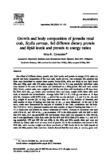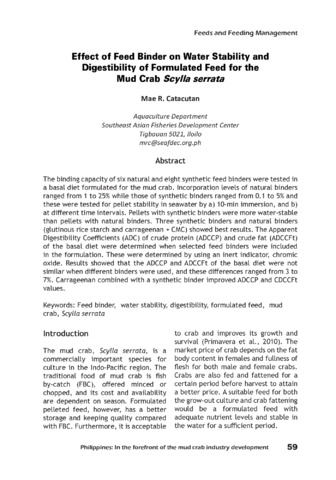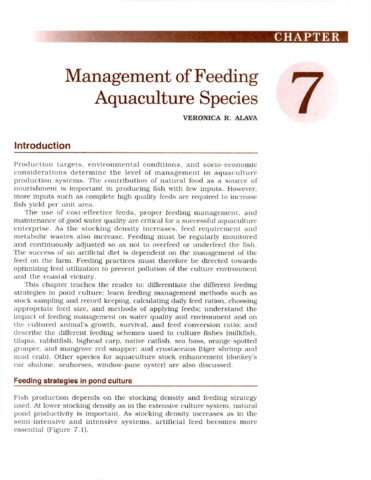Growth and body composition of juvenile mud crab, Scylla serrata, fed different dietary protein and lipid levels and protein to energy ratios.

View/Open
Date
2002Author
Page views
439Metadata
Show full item recordCited times in Scopus
153 readers on Mendeley
- Citations
- CrossRef - Citation Indexes: 51
- Policy Citation - Policy Citations: 1
- Scopus - Citation Indexes: 116
- Captures
- Mendeley - Readers: 153
Share
Abstract
The effect of different dietary protein and lipid levels, and protein to energy (P/E) ratios on growth and body composition of the mud crab, Scylla serrata, was evaluated. Six practical test diets were formulated to contain three protein levels (32%, 40% and 48%) at two lipid levels (6% and 12%), each with P/E ratios ranging from 20.5 to 31.1 mg protein/kJ. Individual crabs were stocked in 36 units of 60-l tanks and maintained on a 40% protein diet until each molted (M0). Newly molted crabs were weighed and fed the test diets until termination at 30 days from the third molt (M3+30). Crabs were monitored daily and body weight (BW) taken after each molt, at intermolt and at termination. Average initial BW (11.18±0.66 g) was taken at 18 days after M0. Carapace width (CW) at M3+30 and of the exuviae (at molt 1, 2, and 3 or M1, M2 and M3), weight of exuviae (M1 to M3), feed conversion ratio or FCR, duration of intermolt, and total number of days of feeding test diets (M0 to M3+30) were determined. At the end of the study, crabs were freeze-dried for analysis of nutrients in the flesh, exoskeleton and fat body. The FCR (3.21–4.21), intermolt duration and total number of days of feeding test diets (111.3–131.2 days) were not affected by dietary treatments (P>0.05). Analysis of covariance was used with CW at M1 and BW at M0+18 as covariates. CW in the 40% protein with 6% lipid or 40/6 diet (P/E ratio, 27.5 mg protein/kJ) did not increase when lipid was increased to 12% (40/12), and it was significantly wider than crabs fed the 48/6 and 48/12 diets (P/E ratios, 31.1 and 27.2 mg protein/kJ). CW and BW did not differ in the 40% and 32% protein diets and were not affected by dietary lipid level at every level of protein. Ca in the exoskeleton was lowest in the 32/6 diet, while exuviae weight was about one-fourth of BW. Crude fat in the lipid deposit of crabs fed 48% protein diets were low. Results showed that the mud crab, S. serrata, grow well when fed diets containing 32–40% dietary protein with either 6% or 12% lipid at dietary energy ranging from 14.7–17.6 MJ/kg.
Suggested Citation
Catacutan, M. R. (2002). Growth and body composition of juvenile mud crab, Scylla serrata, fed different dietary protein and lipid levels and protein to energy ratios. Aquaculture , 208(1-2), 113-123. https://doi.org/10.1016/S0044-8486(01)00709-8
Subject
Taxonomic term
Collections
- AQD Journal Articles [1248]
Related items
Showing items related by title, author, creator and subject.
-
Effect of feed binder on water stability and digestibility of formulated feed for the mud crab Scylla serrata
Catacutan, Mae R. (Aquaculture Department, Southeast Asian Fisheries Development Center, 2017)The binding capacity of six natural and eight synthetic feed binders were tested in a basal diet formulated for the mud crab. Incorporation levels of natural binders ranged from 1 to 25% while those of synthetic binders ... -
Apparent digestibility of selected feedstuffs by mud crab, Scylla serrata
Catacutan, Mae R.; Eusebio, Perla S.; Teshima, Shin-ichi (Elsevier, 2003)A feeding experiment was conducted to determine apparent digestibility coefficients for dry matter (ADMD), crude protein (ACPD), crude fat (ACFD), crude fiber (ACFbD), nitrogen-free extract or NFE (ANFED), and crude ash ... -
Management of feeding aquaculture species
Alava, Veronica R. (Aquaculture Department, Southeast Asian Fisheries Development Center, 2002)This chapter teaches the reader to: differentiate the different feeding strategies in pond culture; learn feeding management methods such as stock sampling and record keeping, calculating daily feed ration, choosing ...




